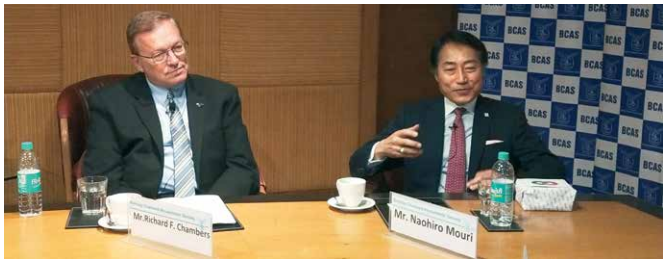1. Background
Liberalised
Remittance Scheme [LRS / the Scheme] was introduced vide AP (DIR Series)
Circular No. 64 dated 4th February, 2004 read with Notification No.
207(E) dated 23rd March, 2004.
LRS was
introduced as a liberalisation measure to facilitate resident individuals to
remit funds abroad for permitted capital or current account transactions or
combination of both.
Presently, FED
Master Direction No. 7/ 2015-16 dated January 1, 2016 (updated as on 12th
April, 2017) [LRS Master Direction] and FAQs on LRS dated 11th August,
2016 [LRS FAQs], explain the provisions of the LRS.
2. LRS Limit
Currently,
under LRS, Authorised Dealers [ADs] may freely allow remittances by resident
individuals up to USD 2,50,000 per Financial Year (April-March) for any
permitted current or capital account transaction or a combination of both.
Consistent
with prevailing macro and micro economic conditions, the LRS limit has been
revised in stages. During the period from February 4, 2004 till date, the LRS
limit has been revised as under:
|
Date |
Feb 4, 2004 |
Dec 20, 2006 |
May 8, 2007 |
Sep 26, 2007 |
Aug 14, 2013 |
Jun 3, 2014 |
May 26, 2015 |
|
LRS limit (USD) |
25,000 |
50,000 |
1,00,000 |
2,00,000 |
75,000 |
1,25,000 |
2,50,000 |
Subsumes
remittances for current account transactions
Previously, there
were separate limits in respect of current account transactions. With effect
from 26th May 2015, LRS limit was increased to USD 2,50,000 per FY.
The increased limit now also includes/subsumes remittance limit for current
account transactions available to resident individuals under Para 1 of Schedule
III to Current Account Transactions Rules, as amended.
Clause 1(ix) of
the Schedule III to Current Account Transactions Rules, provides ‘Any other
Current Account Transaction’. However, Current Account Transactions Rules do
not clarify the type of transactions that are covered under this residual
clause and also whether there will be separate limits for those transactions or
that they too will be subsumed within LRS limit. Specific RBI approval will be
required for any transaction above the LRS limit.
Consolidation
and Clubbing
Members of a family
can consolidate their individual remittances under the Scheme if each of the
individual family member complies with all the terms and conditions. However,
in case of capital account transactions such as opening a bank
account/investment/purchase of property, etc. consolidation by family members
is not permitted if the remitting family member is not a co-owner/co-partner in
the overseas bank account/investment/property. Apparently, this is because a
resident cannot draw foreign currency to make gift to another resident in
foreign currency even if such gift is made by way of credit to the latter’s
overseas foreign currency account held under LRS.
3. Availability of the LRS
– LRS is available to all resident
individuals including minors. In case of remitter being a minor, the Form
A2 must be countersigned by the minor’s natural guardian.
– LRS not available to Corporates,
Partnership firms, HUF, Trusts, etc.
– Remittance by sole proprietor under LRS
In case of a
sole proprietorship business, there is no legal distinction between the
individual / owner and the business. Hence, the owner of the business (in his
personal name and not in the name of the business) can make remittance up to
the
permissible limit under LRS. If the owner of the sole proprietorship business
intends to remit the money from the bank account of the sole proprietorship
business, then the eligibility of the proprietor only in his individual
capacity should be considered. Hence, if an individual in his own capacity
remits USD 250,000 in a financial year under LRS, he cannot remit another USD
250,000 in his capacity as owner of the sole proprietorship business.
4. Permissible/Prohibited
transactions under LRS
4.1 Permissible
Capital Account Transactions
Para A.6 of
the LRS Master directions provides that the permissible capital account
transactions by an individual under LRS are:
– opening of foreign currency account abroad
with a bank;
– purchase of property abroad;
– making investments abroad – acquisition and
holding shares of both listed and unlisted overseas company or debt
instruments; acquisition of qualification shares of an overseas company for
holding the post of Director; acquisition of shares of a foreign company towards
professional services rendered or in lieu of Director’s remuneration;
investment in units of Mutual Funds, Venture Capital Funds, unrated debt
securities, promissory notes;
– setting up Wholly Owned Subsidiaries and Joint
Ventures1 (with effect from August 05, 2013) outside India for bona
fide business subject to the terms & conditions stipulated in Notification
No. FEMA. 263/ RB-2013 dated March 5, 2013;
– extending loans including loans in Indian
Rupees to Non-resident Indians (NRIs) who are relatives as defined in Companies
Act, 1956.
4.2 Permissible
Current Account Transactions
As
mentioned earlier, limit of USD 2,50,000 per FY subsumes earlier separate
limits for remittances under Current Account Transactions Rules (viz. private
visit; gift/donation; going abroad on employment; emigration; maintenance of
close relatives abroad; business trip; medical treatment abroad; studies
abroad). Release of foreign exchange exceeding USD 2,50,000, requires prior
permission from the RBI.
a. Private
Visits
For private
visits abroad, other than to Nepal and Bhutan, any resident individual can
obtain foreign exchange up to an aggregate amount of USD 2,50,000, from an AD
or FFMC, in any one financial year, irrespective of the number of visits
undertaken during the year.
Further,
all tour related expenses including cost of rail/road/water transportation;
cost of Euro Rail; passes/tickets, etc. outside India; and overseas
hotel/lodging expenses shall be subsumed under the LRS limit. The tour operator
can collect this amount either in Indian rupees or in foreign currency from the
resident traveller.
b. Gift /
Donation
Any
resident individual may remit up to USD 2,50,000 in one FY as gift to a person
residing outside India or as donation to an organization outside India.
c. Going abroad
on employment
A person
going abroad for employment can draw foreign exchange up to USD 2,50,000 per FY
from any AD in India.
d. Emigration
A person
emigrating from India can draw foreign exchange from AD Category I bank and AD
Category II up to the amount prescribed by the country of emigration or USD
250,000. Remittance of any amount of foreign exchange outside India in excess
of this limit may be allowed only towards meeting incidental expenses in the
country of immigration and not for earning points or credits to become eligible
for immigration by way of overseas investments in government bonds; land;
commercial enterprise; etc.
e. Maintenance
of close relatives abroad
A resident
individual can remit up-to USD 2,50,000 per FY towards maintenance of close
relatives [‘relative’ as defined in section 6 of the Indian Companies Act,
1956] abroad.
f. Business
Trip
Visits by
individuals for attending an international conference, seminar, specialised
training, apprentice training, etc., are treated as business visits. For
business trips to foreign countries, resident individuals can avail of foreign
exchange up to USD 2,50,000 in a FY irrespective of the number of visits
undertaken during the year.
If an employee
is deputed by the employer for any of the above and the expenses are borne by
the employer, such expenses shall be treated as residual current account
transactions outside LRS and may be permitted by the AD without any limit,
subject to verifying the bona fide of the transaction.
g. Medical
Treatment Abroad
release foreign exchange up to an amount of USD 2,50,000 or its equivalent per
FY without insisting on any estimate from a hospital/doctor. For amount
exceeding the above limit, ADs may release foreign exchange under general
permission based on the estimate from the doctor in India or hospital/ doctor
abroad. A person who has fallen sick after proceeding abroad may also be
released foreign exchange by an AD (without seeking prior approval of the RBI)
for medical treatment outside India.
In addition
to the above, an amount up to USD 250,000 per financial year is allowed to a
person for accompanying as attendant to a patient going abroad for medical
treatment/check-up.
h. Facilities
available to students for pursuing their studies abroad.
AD Category
I banks and AD Category II, may release foreign exchange up to USD 2,50,000 or
its equivalent to resident individuals for studies abroad without insisting on
any estimate from the foreign University. However, AD Category I bank and AD
Category II may allow remittances (without seeking prior approval of the RBI) exceeding
USD 2,50,000 based on the estimate received from the institution abroad
i. Purchasing
Objects of Art
Remittances
under the Scheme can be used for purchasing objects of art subject to the
provisions of other applicable laws such as the extant Foreign Trade Policy of
the Government of India.
5. Outward remittance in the form of a DD
The Scheme
can be used for outward remittance in the form of a DD either in the resident
individual’s own name or in the name of beneficiary with whom he intends putting
through the permissible transactions at the time of private visit abroad,
against self-declaration of the remitter in the format prescribed.
6. Open, maintain and hold Foreign Currency
Accounts
Individuals can
also open, maintain and hold foreign currency accounts with a bank outside
India for making remittances under the Scheme without prior approval of the
Reserve Bank. The foreign currency accounts may be used for putting through all
transactions connected with or arising from remittances eligible under this
Scheme.
7. Prohibitions under LRS
7.1 Question
2 of the LRS FAQs provides that the remittance facility under the scheme is not
available for the following:
– The Scheme is not available for remittances
for any purpose specifically prohibited under Schedule I or any item restricted
under Schedule II of Foreign Exchange Management (Current Account Transaction)
Rules, 2000, dated May 3, 2000, as amended from time to time.
– Remittance from India for margins or margin
calls to overseas exchanges / overseas counterparty.
– Remittances for purchase of FCCBs issued by
Indian companies in the overseas secondary market.
– Remittance for trading in foreign exchange
abroad.
– Capital account remittances, directly or
indirectly, to countries identified by the Financial Action Task Force (FATF)
as “non- cooperative countries and territories”, from time to time.
– Remittances
directly or indirectly to those individuals and entities identified as posing
significant risk of committing acts of terrorism as advised separately by the
Reserve Bank to the banks.
In addition,
Banks should not extend any kind of credit facilities to resident individuals
to facilitate capital account remittances under the Scheme.
7.2 Holding
Gold Abroad
Under LRS a
person can remit for any purpose except those specifically prohibited.
LRS Master
Direction provides a positive list of transactions permitted and FAQs of 2016
provides a negative list of transactions which are not permitted.
Though not
specifically prohibited, it is understood that RBI is not in favour of using
remittances under LRS for holding gold abroad.
7.3 Providing
Loans Abroad
Due to
positive / negative list, though not specifically prohibited, it is understood
that RBI is not in favour of using remittances under LRS for giving loans
abroad.
8. Procedure for remittances under LRS
The
individual should designate a branch of an AD through which all the remittances
under the Scheme will be made. The resident individual seeking to make the remittance
should furnish extant Form A2 for purchase of foreign exchange under LRS.
9. Overseas Direct Investment by Individuals
under LRS
Regulation 20A of the Foreign Exchange Management
(Transfer or issue of any Foreign Security) Regulations, 2004 [FEMA 120]
provides that a resident individual (single or in association with another
resident individual or with an ‘Indian Party’ as defined in this Notification) satisfying
the criteria as per Schedule V of this Notification, may make overseas
direct investment in the equity shares and compulsorily convertible
preference shares of a Joint Venture (JV) or Wholly Owned Subsidiary (WOS)
outside India.
Para 5 of
the Schedule provides that at the time of investments, the permissible ceiling
shall be within the overall ceiling prescribed for the resident individual under Liberalised
Remittance Scheme as prescribed by the Reserve Bank from time to time.
Explanation:
The investment made out of the balances held in EEFC/RFC account shall also
be restricted to the limit prescribed under LRS.
A resident
individual who has made overseas direct investment in the equity shares;
compulsorily convertible preference shares of a JV/WoS outside India or ESOPs,
within the LRS limit, will be required to comply with the terms and conditions
prescribed by the overseas investment guidelines in Schedule V of FEMA 120 vide
Notification No. FEMA 263/ RB-2013 dated March 5, 2013.
No ratings
or guidelines have been prescribed under LRS of USD 2,50,000 on the quality of
the investment an individual can make. However, the individual investor is
expected to exercise due diligence while taking a decision regarding the investments
which he or she proposes to make
10. Rupee Loan by a resident individual to a
NRI/PIO who is a close relative
A resident individual is permitted to make a rupee
loan to a NRI/PIO who is a close relative of the resident individual
(‘relative’ as defined in section 2(77) of the Companies Act, 2013) by way of
crossed cheque/ electronic transfer subject to the following conditions:
a. The loan is free
of interest and the minimum maturity of the loan is one year.
b. The loan, though
in rupees, should be within the overall LRS limit of USD 2,50,000, per
financial year, available to the resident individual. It is the responsibility
of the lender to ensure that the amount of loan is within the LRS limit of USD
2,50,000 during the financial year.
c. The loan should
be utilised for meeting the borrower’s personal requirements or for his own
business purposes in India.
d. The loan should
not be utilised, either singly or in association with other person, for any of
the activities in which investment by persons resident outside India is
prohibited, namely;
– the business of chit fund, or
– Nidhi Company, or
– agricultural or plantation activities or in
real estate business, or construction of farmhouses, or
– trading in Transferable Development Rights
(TDRs).
Explanation:
For this purpose, real estate business shall not include development of
townships, construction of residential / commercial premises, roads or bridges.
e. The loan amount
should be credited to the NRO a/c of the NRI / PIO. Credit of such loan amount
may be treated as an eligible credit to NRO a/c.
f. The loan amount
shall not be remitted outside India.
g. Repayment of
loan shall be made by way of inward remittances through normal banking channels
or by debit to the Non-resident Ordinary (NRO) / Non-resident External (NRE) /
Foreign Currency Non-resident (FCNR) account of the borrower or out of the sale
proceeds of the shares or securities or immovable property against which such
loan was granted.
major changes in the LRS which were brought about by Notification No. FEMA.
263/RB-2013 dated March 5, 2013 in respect of investment outside India,
Notification No. G.S.R. 426(E) dated May 26, 2015 issued by Ministry of Finance
in respect of limits under LRS and Notification No. FEMA. 341/2015-RB dated May
26, 2015 in respect of subsuming of limits under Current Account Transactions
Rules in a holistic manner. This apart, there could be some contentious issues.
However, in the absence of any official clarification, it may not be proper to
consider these.









